Looks like our solar system is a very interesting place. Scientists regularly suggest that the surface or structure of a celestial body will be uniform and boring. But in reality, on the site of a dull landscape, there is a complex relief or structure, which lives by its still unknown laws. So wrong with Titan and Pluto. And the first scientific data from the Juno probe show that scientists made the same mistake with Jupiter - it turned out to be much more complicated and interesting than they thought.
According to Juno team scientists, their work is similar to this collage. Posted by: Kisala-78Very general information
The Juno probe (“Juno”, the wife of Jupiter in mythology) has been working in polar high-elliptical orbit since the beginning of July 2016. “Polar” means that the device flies near the poles, and “highly elliptical” means that out of 53 days of one revolution, the flight near Jupiter takes only about two hours. It was planned that the probe will move to a 14-day orbit, but due to the accident of the motor system, it was left at the intermediate 53-day one. The scientific instruments of “Juno” allow to look under different clouds in different ranges, and the camera of the visible range is a secondary tool. In more detail about the probe, flight and the equipment it is possible to
read here . Before Juno, there was only one probe in Jupiter’s orbit: the Galileo, which worked there from 1995 to 2003 and was planned to be sent to the atmosphere of Jupiter to avoid the introduction of terrestrial microorganisms to its satellites, and in the process of descending, transmit scientific data about the upper atmosphere.
Ammoniac poetry
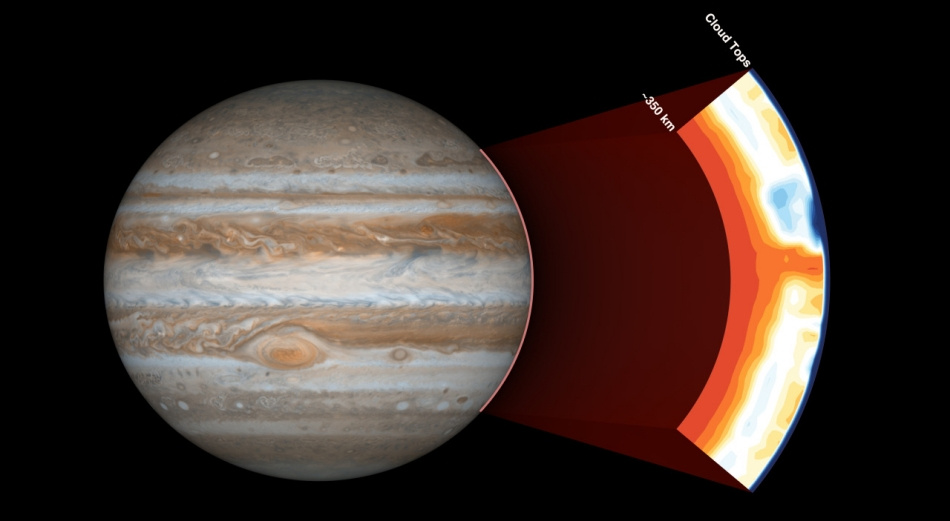 Source: NASA
Source: NASAThis is the distribution of ammonia under the cloud layer according to the MWR microwave radiometer. Red - more ammonia, blue - less. Below the clouds, which we see as the "surface" of Jupiter, there is no sunlight. It was expected that in such conditions ammonia would reach a uniform level at a much smaller depth than it turned out. And its distribution shows that Jupiter is less evenly mixed than expected. This explains the unexpected data that Galileo transmitted during its final descent. In 2003, scientists suggested that Galileo got into a random, warmer section, but now it turned out that the descent of probes in different parts of the atmosphere would be unique due to the complexity of its structure.
The equatorial ammonia belt, which is visible as a red stripe in the center, also has no explanation yet. It may be similar to the earth
cell of Hadley , where humid air rises up near the equator, participating in the circulation of the earth's atmosphere. Or maybe not - the solid surface of the Earth, which restricts circulation, is much closer to the upper boundary of the atmosphere than something similar to that of Jupiter. Perhaps this equatorial ammonia band extends to a great depth; only subsequent vehicles, which look even deeper, will be able to recognize it.
Fluffy core
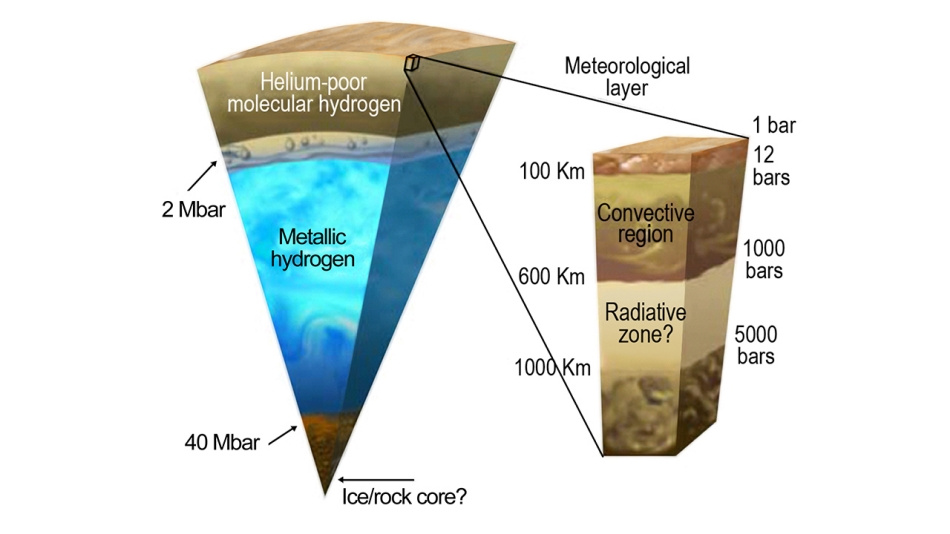 The structure of Jupiter, source: NASA
The structure of Jupiter, source: NASAIn the paragraph above, I deliberately wrote “something similar” instead of the “surface” or “core” of Jupiter. The fact is that one of the tasks of Juno is an attempt to determine whether Jupiter has a nucleus. Scientists expected that the gravitational measurements of the GSE experiment would reveal either a small ice or stone core (given the pressure in the center of Jupiter for more than 40 million atmospheres, this is not ice or stone that we are used to, but something very specific in itself) or their absence . The data obtained indicate a third, unexpected version - a huge fuzzy core. Something in the center of Jupiter, much more than expected, may be partially liquid and, in addition, may even be associated with processes in the atmosphere. In terrestrial conditions, it is possible that a pale semblance of such a phenomenon are rains with stones or animals that were raised up by a tornado.
Expressive magnetic field
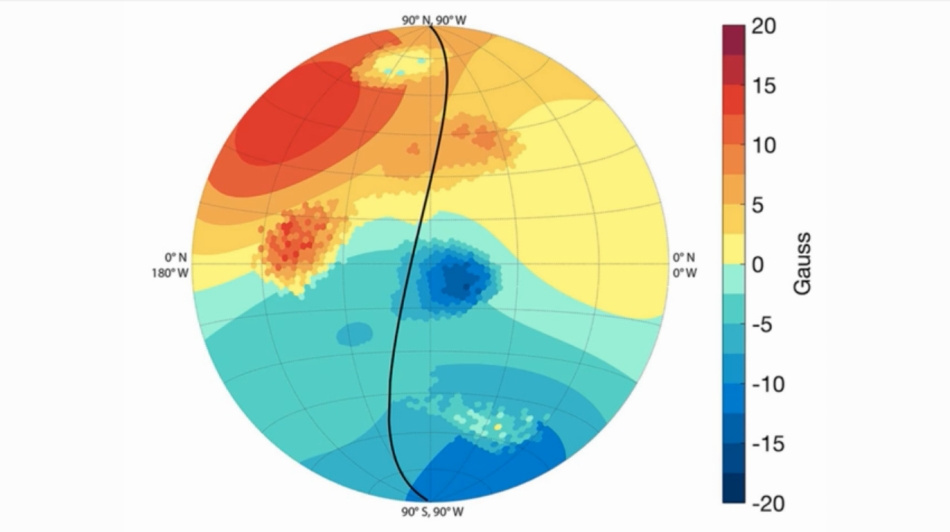 Source: NASA
Source: NASAThe magnetic field also brought surprises. First of all, it turned out to be more “expressive” - where it was supposed to be strong, it turned out to be even stronger, and where it should have been weak, weaker. Further, it also turned out to be uneven. In the figure above, the black line is the “Juno” track. Five prominent spots are places where the magnetic field had to differ from the background (red is stronger, blue is weaker) in order to get the values collected on the black track. The non-uniformity of the magnetic field may indicate that the
planetary dynamo is located above the zone of metallic hydrogen, in the zone of molecular hydrogen.
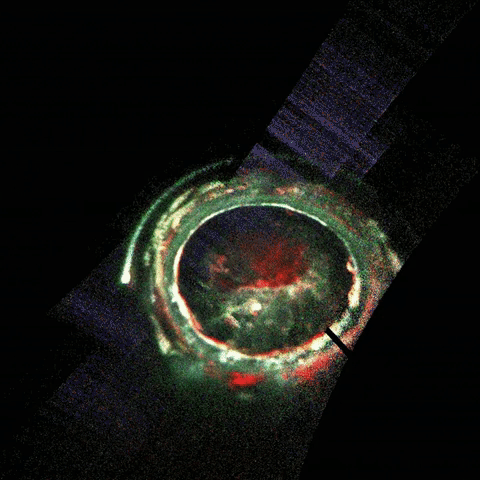 Auroras at the south pole in the ultraviolet range, photo by NASA
Auroras at the south pole in the ultraviolet range, photo by NASAThanks to the polar orbit, Juno can look at the planet from above and below, which makes it possible for the first time to fully see the most complex systems of auroras. In the animation above, the outermost stroke with a long tail is generated by the satellite Io. Pay attention to the colored areas - white, green and red. It seems that the red zones are zones of electron emission, which is very unusual, because the aurora is, on the contrary, the zone of entry of charged particles into the atmosphere.
Every bit in line
Even service devices like the star sensor, which is used to determine the position of the device in space, have been able to bring to the service of science. Large solar panels, which were not available on previous devices (radioisotope generators were used there), could be turned into dust detectors - micrometeorite strikes were recorded by inertial systems, and the knocked out particles were captured with a stellar sensor.
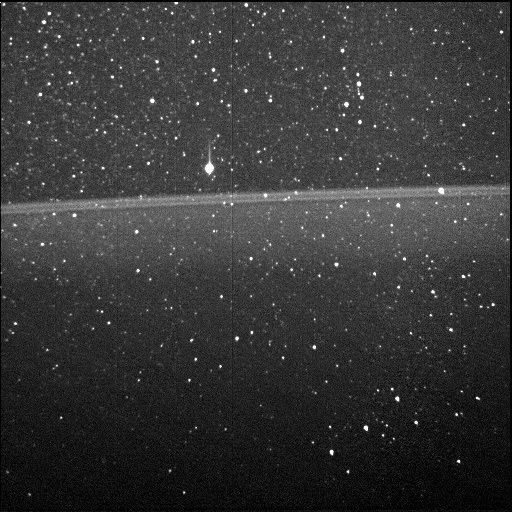 Source: NASA
Source: NASAAnd this photo is the first ever photo of the rings of Jupiter from the inside. "Juno" was at a distance of slightly less than 5000 km and made this photo using a star sensor. Even the background turned out to be remarkable, the upper part of the Orion constellation hit the frame, and the bright star is Betelgeuse.
The combination of art and science
Some of the results can be attributed to the category and science and art at the same time. Descending into the Jupiter ionosphere, Juno recorded plasma waves with the Waves instrument antennas. The data obtained was slowed 60 times and got the sound of a gas giant. Pure high sounds are most likely related to the interaction of the “Juno” itself with the ionosphere, but this issue requires further study.
And, of course, it is impossible not to admire the views that we can observe thanks to the JunoCam optical camera. For example, an image of the south pole of Jupiter glued together from several photographs. In reality, the poles are illuminated only half due to the slight inclination of the axis of rotation of the planet, but thanks to image processing by enthusiasts, we can see the pole in all its glory.
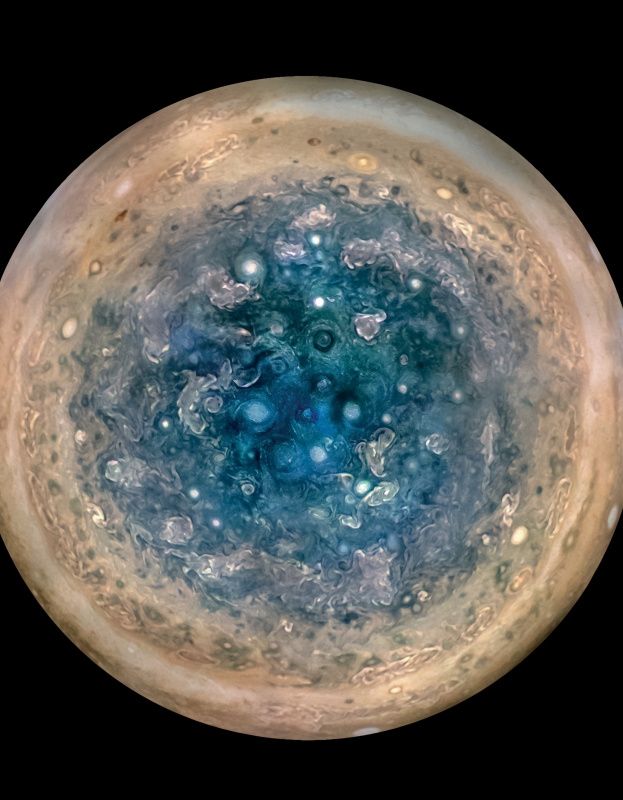 Full size image , Credits: NASA / JPL-Caltech / SwRI / MSSS / Betsy Asher Hall / Gervasio Robles
Full size image , Credits: NASA / JPL-Caltech / SwRI / MSSS / Betsy Asher Hall / Gervasio RoblesAnd here the magnetic pole of the planet and the axis of rotation are clearly visible. Like Earth, they are not far from each other.
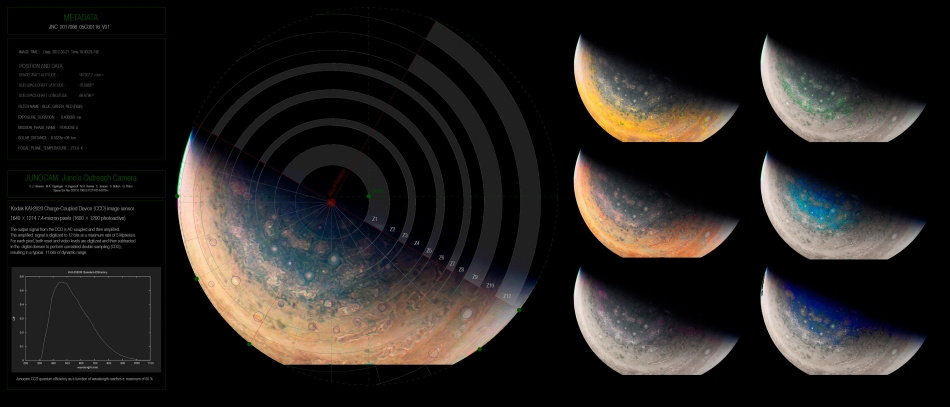 Full-size image , the author of the collage _CLEAR_, NASA image
Full-size image , the author of the collage _CLEAR_, NASA imageAnd in this photo we see waves of clouds in the region of 38 latitude. Bright, small clouds are lines of squalls formed by a cold, atmospheric front. Their width is about 25 km. On Earth, the squall lines in front of the cold front create strong descending flows and wind shear very dangerous for aircraft. The white color of the clouds says that they consist of water and / or ammonia ice.
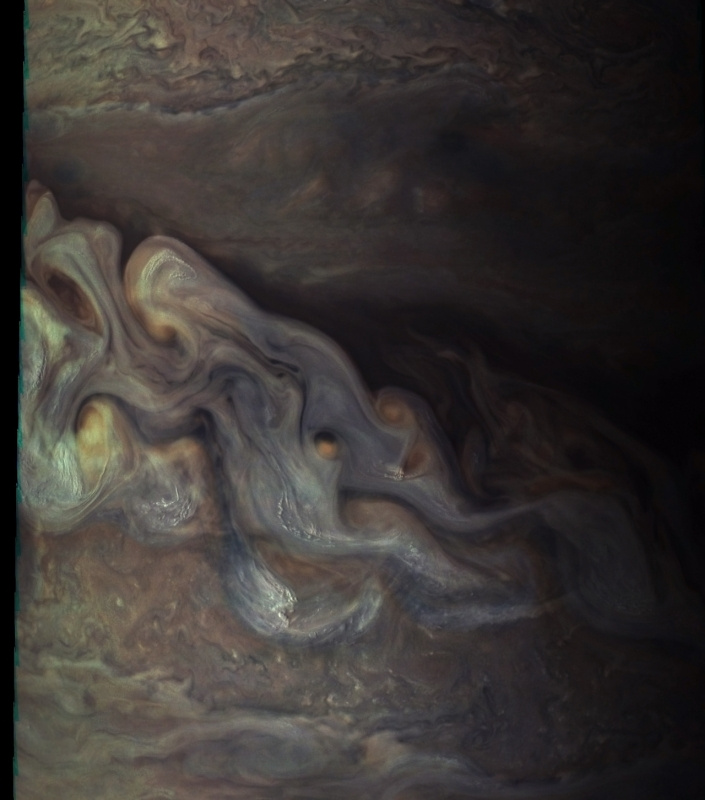 Photo in full size , source: NASA
Photo in full size , source: NASAConclusion
July 11, at the next round, "Yunon" is waiting for one of the most interesting adventures - it will take place over the Big Red Spot, a giant anticyclone that has been spinning in the atmosphere of Jupiter for at least three hundred years. Without a doubt, we are waiting for even more interesting science and beautiful photos.